Mental Health Case Study: Parent-Infant Relationship of Lucas and Lucy
VerifiedAdded on 2023/01/06
|11
|3337
|92
Case Study
AI Summary
This case study examines the mental health challenges faced by Lucas and his infant daughter, Lucy. It begins with an introduction to parental mental health and its impact on the parent-child relationship. The report then assesses Lucas's situation, the infant's condition, and the parent-infant relationship, highlighting issues such as Lucas's stress and Lucy's poor feeding. It identifies potential risks, including Lucas's psychomotor agitation and Lucy's undernutrition, while also acknowledging protective factors like Lucas's sensitivity towards his baby. Care objectives are established for the parent, infant, and the parent-infant relationship, followed by a detailed management plan that includes interventions such as stress reduction techniques and nutritional support. The report suggests recommended support services and concludes with an evaluation of potential progress and outcomes, offering a reflective analysis of the case and its implications. The document provides a thorough analysis of the family's situation, including recommendations for support and a plan for the future.
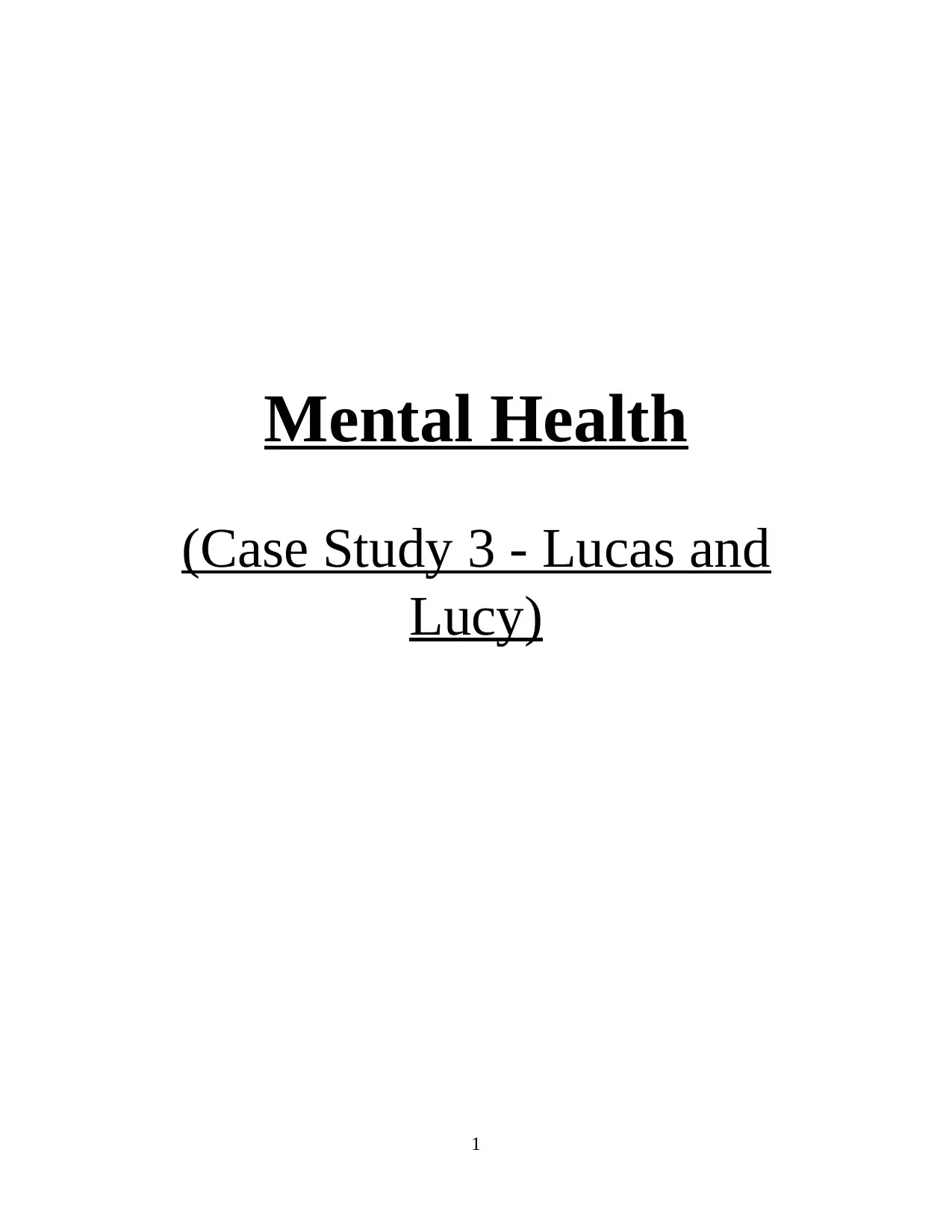
Mental Health
(Case Study 3 - Lucas and
Lucy)
1
(Case Study 3 - Lucas and
Lucy)
1
Paraphrase This Document
Need a fresh take? Get an instant paraphrase of this document with our AI Paraphraser
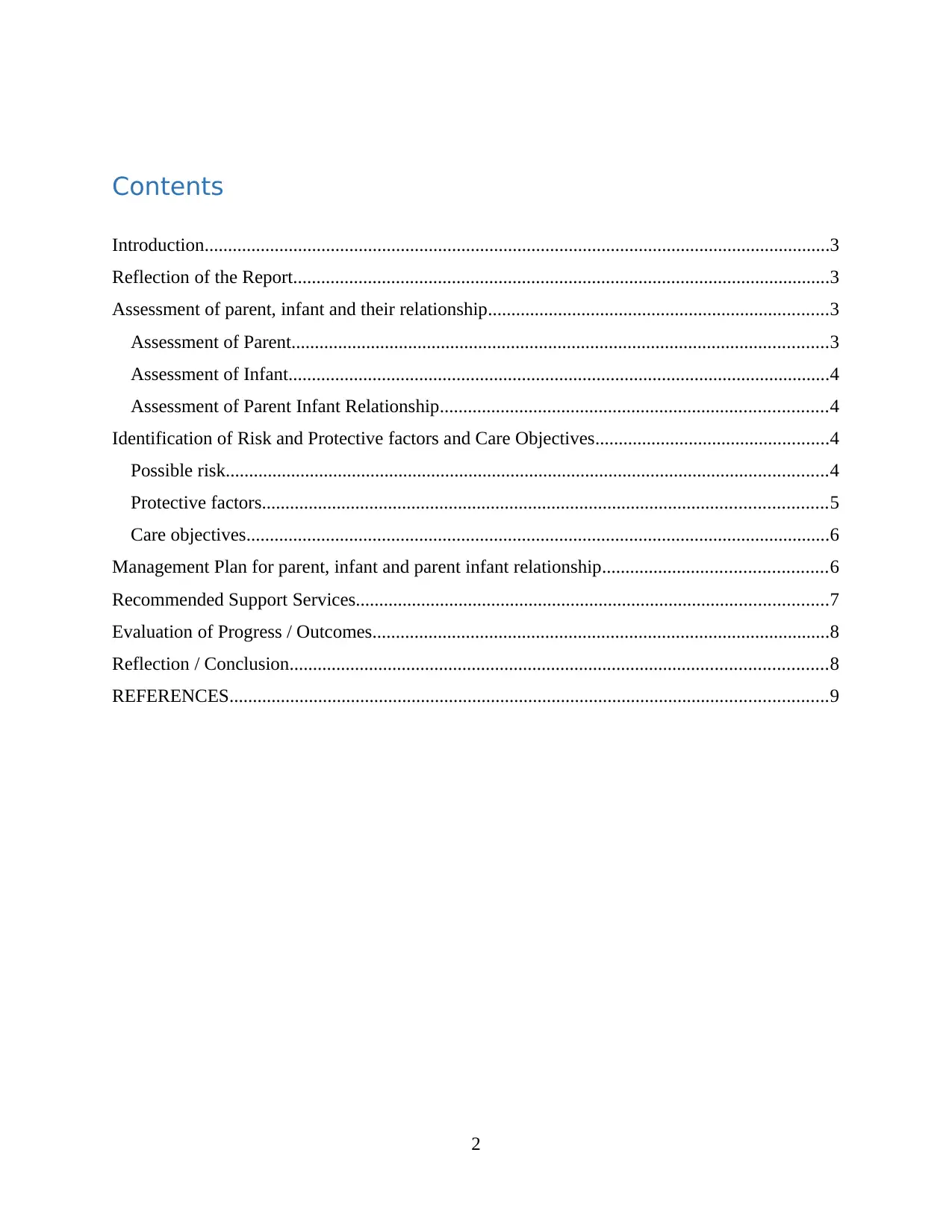
Contents
Introduction......................................................................................................................................3
Reflection of the Report...................................................................................................................3
Assessment of parent, infant and their relationship.........................................................................3
Assessment of Parent...................................................................................................................3
Assessment of Infant....................................................................................................................4
Assessment of Parent Infant Relationship...................................................................................4
Identification of Risk and Protective factors and Care Objectives..................................................4
Possible risk.................................................................................................................................4
Protective factors.........................................................................................................................5
Care objectives.............................................................................................................................6
Management Plan for parent, infant and parent infant relationship................................................6
Recommended Support Services.....................................................................................................7
Evaluation of Progress / Outcomes..................................................................................................8
Reflection / Conclusion...................................................................................................................8
REFERENCES................................................................................................................................9
2
Introduction......................................................................................................................................3
Reflection of the Report...................................................................................................................3
Assessment of parent, infant and their relationship.........................................................................3
Assessment of Parent...................................................................................................................3
Assessment of Infant....................................................................................................................4
Assessment of Parent Infant Relationship...................................................................................4
Identification of Risk and Protective factors and Care Objectives..................................................4
Possible risk.................................................................................................................................4
Protective factors.........................................................................................................................5
Care objectives.............................................................................................................................6
Management Plan for parent, infant and parent infant relationship................................................6
Recommended Support Services.....................................................................................................7
Evaluation of Progress / Outcomes..................................................................................................8
Reflection / Conclusion...................................................................................................................8
REFERENCES................................................................................................................................9
2
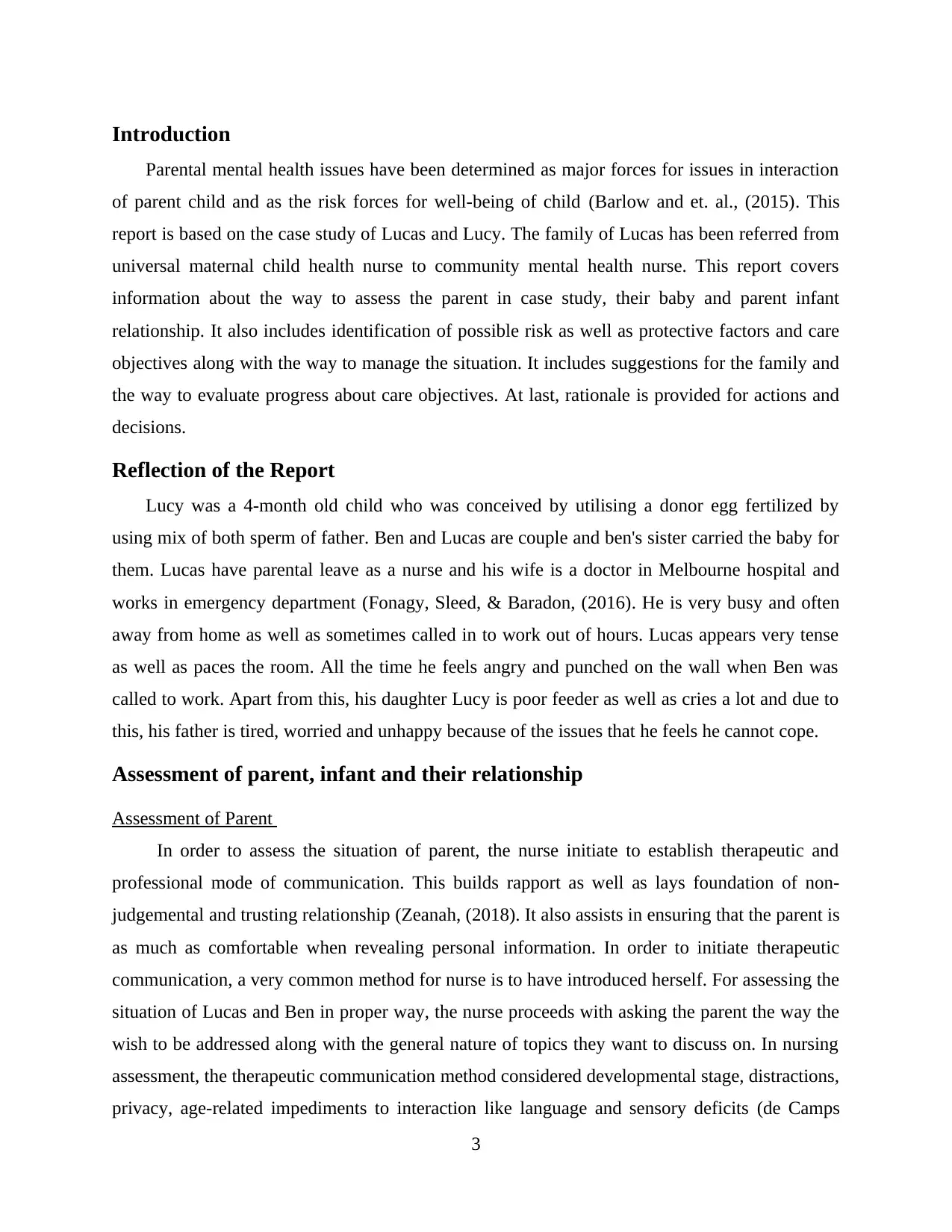
Introduction
Parental mental health issues have been determined as major forces for issues in interaction
of parent child and as the risk forces for well-being of child (Barlow and et. al., (2015). This
report is based on the case study of Lucas and Lucy. The family of Lucas has been referred from
universal maternal child health nurse to community mental health nurse. This report covers
information about the way to assess the parent in case study, their baby and parent infant
relationship. It also includes identification of possible risk as well as protective factors and care
objectives along with the way to manage the situation. It includes suggestions for the family and
the way to evaluate progress about care objectives. At last, rationale is provided for actions and
decisions.
Reflection of the Report
Lucy was a 4-month old child who was conceived by utilising a donor egg fertilized by
using mix of both sperm of father. Ben and Lucas are couple and ben's sister carried the baby for
them. Lucas have parental leave as a nurse and his wife is a doctor in Melbourne hospital and
works in emergency department (Fonagy, Sleed, & Baradon, (2016). He is very busy and often
away from home as well as sometimes called in to work out of hours. Lucas appears very tense
as well as paces the room. All the time he feels angry and punched on the wall when Ben was
called to work. Apart from this, his daughter Lucy is poor feeder as well as cries a lot and due to
this, his father is tired, worried and unhappy because of the issues that he feels he cannot cope.
Assessment of parent, infant and their relationship
Assessment of Parent
In order to assess the situation of parent, the nurse initiate to establish therapeutic and
professional mode of communication. This builds rapport as well as lays foundation of non-
judgemental and trusting relationship (Zeanah, (2018). It also assists in ensuring that the parent is
as much as comfortable when revealing personal information. In order to initiate therapeutic
communication, a very common method for nurse is to have introduced herself. For assessing the
situation of Lucas and Ben in proper way, the nurse proceeds with asking the parent the way the
wish to be addressed along with the general nature of topics they want to discuss on. In nursing
assessment, the therapeutic communication method considered developmental stage, distractions,
privacy, age-related impediments to interaction like language and sensory deficits (de Camps
3
Parental mental health issues have been determined as major forces for issues in interaction
of parent child and as the risk forces for well-being of child (Barlow and et. al., (2015). This
report is based on the case study of Lucas and Lucy. The family of Lucas has been referred from
universal maternal child health nurse to community mental health nurse. This report covers
information about the way to assess the parent in case study, their baby and parent infant
relationship. It also includes identification of possible risk as well as protective factors and care
objectives along with the way to manage the situation. It includes suggestions for the family and
the way to evaluate progress about care objectives. At last, rationale is provided for actions and
decisions.
Reflection of the Report
Lucy was a 4-month old child who was conceived by utilising a donor egg fertilized by
using mix of both sperm of father. Ben and Lucas are couple and ben's sister carried the baby for
them. Lucas have parental leave as a nurse and his wife is a doctor in Melbourne hospital and
works in emergency department (Fonagy, Sleed, & Baradon, (2016). He is very busy and often
away from home as well as sometimes called in to work out of hours. Lucas appears very tense
as well as paces the room. All the time he feels angry and punched on the wall when Ben was
called to work. Apart from this, his daughter Lucy is poor feeder as well as cries a lot and due to
this, his father is tired, worried and unhappy because of the issues that he feels he cannot cope.
Assessment of parent, infant and their relationship
Assessment of Parent
In order to assess the situation of parent, the nurse initiate to establish therapeutic and
professional mode of communication. This builds rapport as well as lays foundation of non-
judgemental and trusting relationship (Zeanah, (2018). It also assists in ensuring that the parent is
as much as comfortable when revealing personal information. In order to initiate therapeutic
communication, a very common method for nurse is to have introduced herself. For assessing the
situation of Lucas and Ben in proper way, the nurse proceeds with asking the parent the way the
wish to be addressed along with the general nature of topics they want to discuss on. In nursing
assessment, the therapeutic communication method considered developmental stage, distractions,
privacy, age-related impediments to interaction like language and sensory deficits (de Camps
3
⊘ This is a preview!⊘
Do you want full access?
Subscribe today to unlock all pages.

Trusted by 1+ million students worldwide
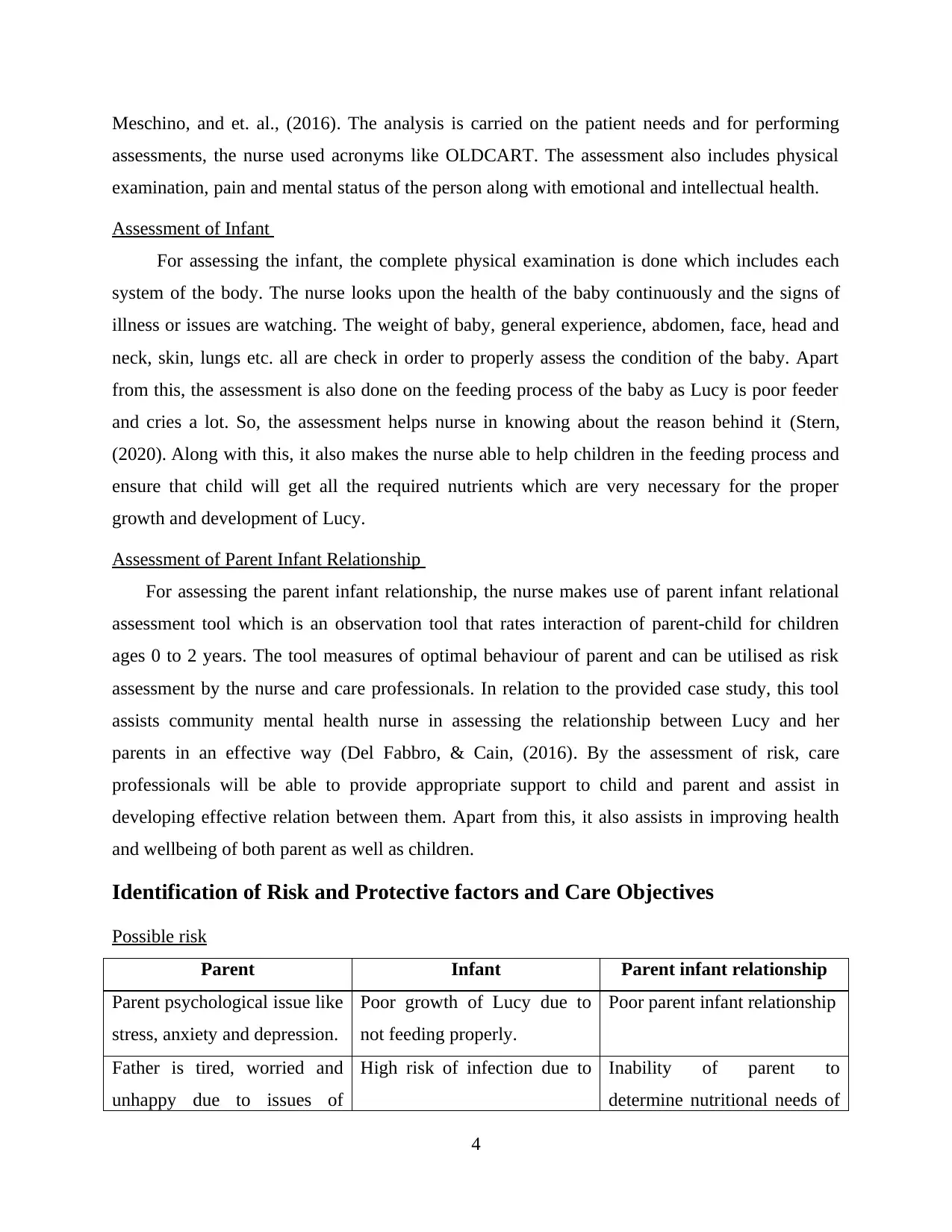
Meschino, and et. al., (2016). The analysis is carried on the patient needs and for performing
assessments, the nurse used acronyms like OLDCART. The assessment also includes physical
examination, pain and mental status of the person along with emotional and intellectual health.
Assessment of Infant
For assessing the infant, the complete physical examination is done which includes each
system of the body. The nurse looks upon the health of the baby continuously and the signs of
illness or issues are watching. The weight of baby, general experience, abdomen, face, head and
neck, skin, lungs etc. all are check in order to properly assess the condition of the baby. Apart
from this, the assessment is also done on the feeding process of the baby as Lucy is poor feeder
and cries a lot. So, the assessment helps nurse in knowing about the reason behind it (Stern,
(2020). Along with this, it also makes the nurse able to help children in the feeding process and
ensure that child will get all the required nutrients which are very necessary for the proper
growth and development of Lucy.
Assessment of Parent Infant Relationship
For assessing the parent infant relationship, the nurse makes use of parent infant relational
assessment tool which is an observation tool that rates interaction of parent-child for children
ages 0 to 2 years. The tool measures of optimal behaviour of parent and can be utilised as risk
assessment by the nurse and care professionals. In relation to the provided case study, this tool
assists community mental health nurse in assessing the relationship between Lucy and her
parents in an effective way (Del Fabbro, & Cain, (2016). By the assessment of risk, care
professionals will be able to provide appropriate support to child and parent and assist in
developing effective relation between them. Apart from this, it also assists in improving health
and wellbeing of both parent as well as children.
Identification of Risk and Protective factors and Care Objectives
Possible risk
Parent Infant Parent infant relationship
Parent psychological issue like
stress, anxiety and depression.
Poor growth of Lucy due to
not feeding properly.
Poor parent infant relationship
Father is tired, worried and
unhappy due to issues of
High risk of infection due to Inability of parent to
determine nutritional needs of
4
assessments, the nurse used acronyms like OLDCART. The assessment also includes physical
examination, pain and mental status of the person along with emotional and intellectual health.
Assessment of Infant
For assessing the infant, the complete physical examination is done which includes each
system of the body. The nurse looks upon the health of the baby continuously and the signs of
illness or issues are watching. The weight of baby, general experience, abdomen, face, head and
neck, skin, lungs etc. all are check in order to properly assess the condition of the baby. Apart
from this, the assessment is also done on the feeding process of the baby as Lucy is poor feeder
and cries a lot. So, the assessment helps nurse in knowing about the reason behind it (Stern,
(2020). Along with this, it also makes the nurse able to help children in the feeding process and
ensure that child will get all the required nutrients which are very necessary for the proper
growth and development of Lucy.
Assessment of Parent Infant Relationship
For assessing the parent infant relationship, the nurse makes use of parent infant relational
assessment tool which is an observation tool that rates interaction of parent-child for children
ages 0 to 2 years. The tool measures of optimal behaviour of parent and can be utilised as risk
assessment by the nurse and care professionals. In relation to the provided case study, this tool
assists community mental health nurse in assessing the relationship between Lucy and her
parents in an effective way (Del Fabbro, & Cain, (2016). By the assessment of risk, care
professionals will be able to provide appropriate support to child and parent and assist in
developing effective relation between them. Apart from this, it also assists in improving health
and wellbeing of both parent as well as children.
Identification of Risk and Protective factors and Care Objectives
Possible risk
Parent Infant Parent infant relationship
Parent psychological issue like
stress, anxiety and depression.
Poor growth of Lucy due to
not feeding properly.
Poor parent infant relationship
Father is tired, worried and
unhappy due to issues of
High risk of infection due to Inability of parent to
determine nutritional needs of
4
Paraphrase This Document
Need a fresh take? Get an instant paraphrase of this document with our AI Paraphraser
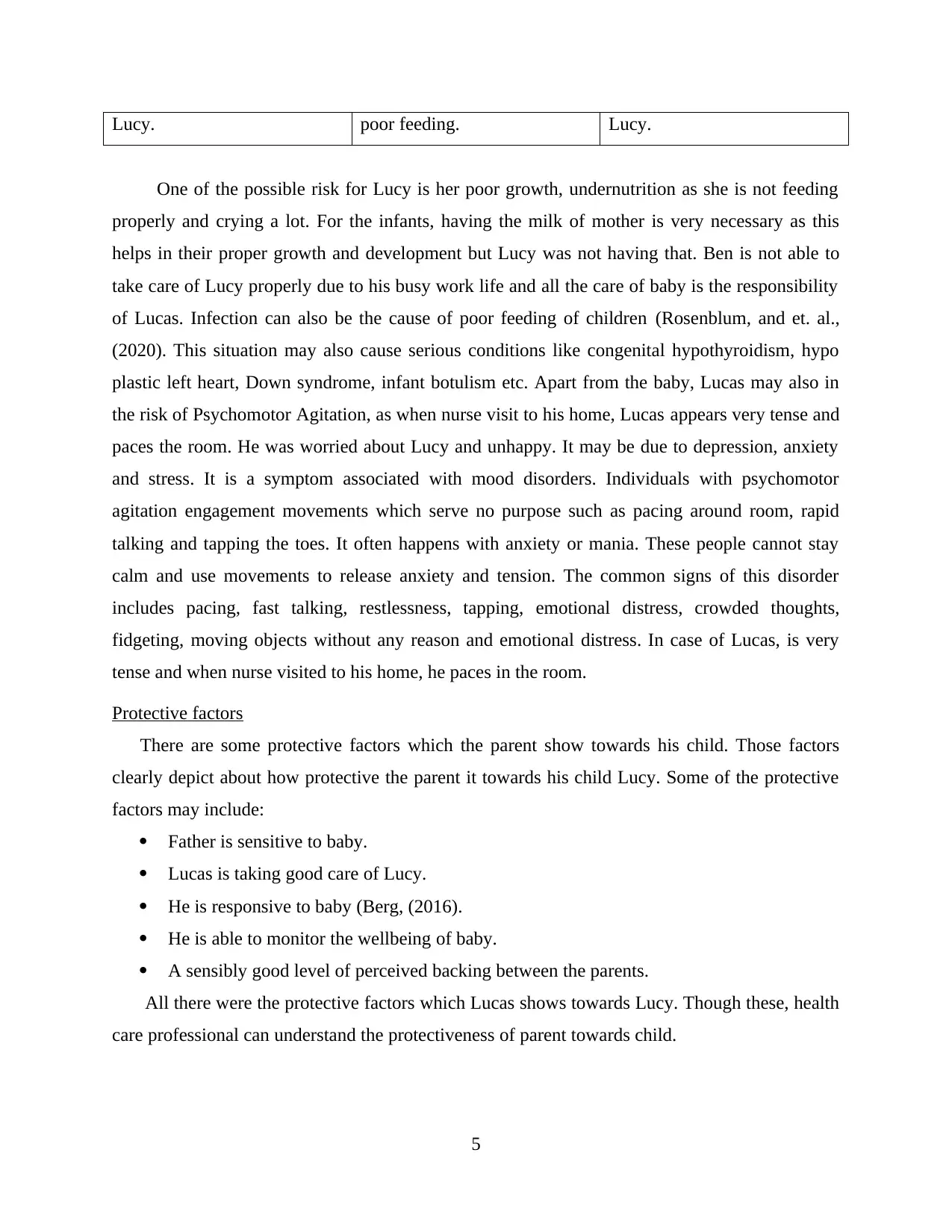
Lucy. poor feeding. Lucy.
One of the possible risk for Lucy is her poor growth, undernutrition as she is not feeding
properly and crying a lot. For the infants, having the milk of mother is very necessary as this
helps in their proper growth and development but Lucy was not having that. Ben is not able to
take care of Lucy properly due to his busy work life and all the care of baby is the responsibility
of Lucas. Infection can also be the cause of poor feeding of children (Rosenblum, and et. al.,
(2020). This situation may also cause serious conditions like congenital hypothyroidism, hypo
plastic left heart, Down syndrome, infant botulism etc. Apart from the baby, Lucas may also in
the risk of Psychomotor Agitation, as when nurse visit to his home, Lucas appears very tense and
paces the room. He was worried about Lucy and unhappy. It may be due to depression, anxiety
and stress. It is a symptom associated with mood disorders. Individuals with psychomotor
agitation engagement movements which serve no purpose such as pacing around room, rapid
talking and tapping the toes. It often happens with anxiety or mania. These people cannot stay
calm and use movements to release anxiety and tension. The common signs of this disorder
includes pacing, fast talking, restlessness, tapping, emotional distress, crowded thoughts,
fidgeting, moving objects without any reason and emotional distress. In case of Lucas, is very
tense and when nurse visited to his home, he paces in the room.
Protective factors
There are some protective factors which the parent show towards his child. Those factors
clearly depict about how protective the parent it towards his child Lucy. Some of the protective
factors may include:
Father is sensitive to baby.
Lucas is taking good care of Lucy.
He is responsive to baby (Berg, (2016).
He is able to monitor the wellbeing of baby.
A sensibly good level of perceived backing between the parents.
All there were the protective factors which Lucas shows towards Lucy. Though these, health
care professional can understand the protectiveness of parent towards child.
5
One of the possible risk for Lucy is her poor growth, undernutrition as she is not feeding
properly and crying a lot. For the infants, having the milk of mother is very necessary as this
helps in their proper growth and development but Lucy was not having that. Ben is not able to
take care of Lucy properly due to his busy work life and all the care of baby is the responsibility
of Lucas. Infection can also be the cause of poor feeding of children (Rosenblum, and et. al.,
(2020). This situation may also cause serious conditions like congenital hypothyroidism, hypo
plastic left heart, Down syndrome, infant botulism etc. Apart from the baby, Lucas may also in
the risk of Psychomotor Agitation, as when nurse visit to his home, Lucas appears very tense and
paces the room. He was worried about Lucy and unhappy. It may be due to depression, anxiety
and stress. It is a symptom associated with mood disorders. Individuals with psychomotor
agitation engagement movements which serve no purpose such as pacing around room, rapid
talking and tapping the toes. It often happens with anxiety or mania. These people cannot stay
calm and use movements to release anxiety and tension. The common signs of this disorder
includes pacing, fast talking, restlessness, tapping, emotional distress, crowded thoughts,
fidgeting, moving objects without any reason and emotional distress. In case of Lucas, is very
tense and when nurse visited to his home, he paces in the room.
Protective factors
There are some protective factors which the parent show towards his child. Those factors
clearly depict about how protective the parent it towards his child Lucy. Some of the protective
factors may include:
Father is sensitive to baby.
Lucas is taking good care of Lucy.
He is responsive to baby (Berg, (2016).
He is able to monitor the wellbeing of baby.
A sensibly good level of perceived backing between the parents.
All there were the protective factors which Lucas shows towards Lucy. Though these, health
care professional can understand the protectiveness of parent towards child.
5
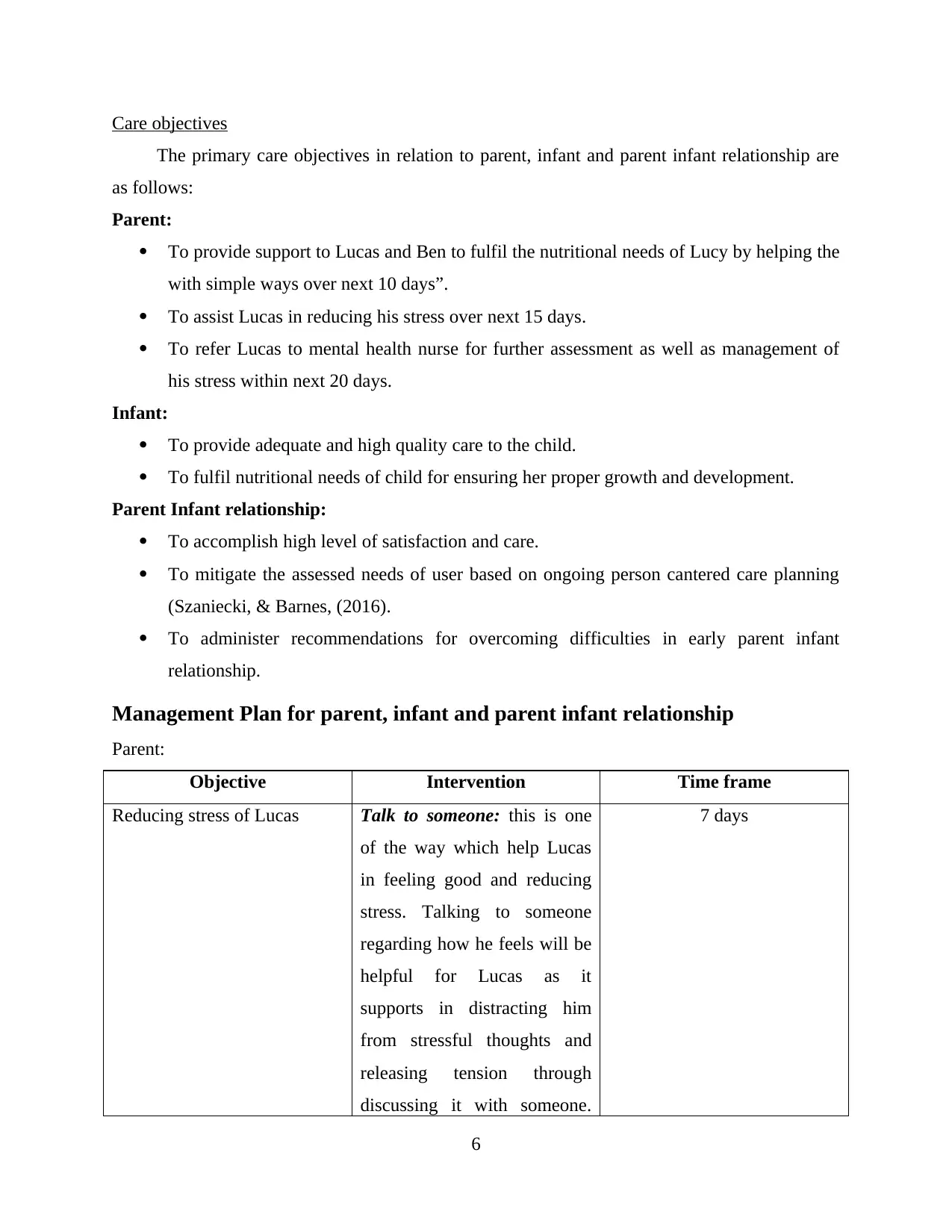
Care objectives
The primary care objectives in relation to parent, infant and parent infant relationship are
as follows:
Parent:
To provide support to Lucas and Ben to fulfil the nutritional needs of Lucy by helping the
with simple ways over next 10 days”.
To assist Lucas in reducing his stress over next 15 days.
To refer Lucas to mental health nurse for further assessment as well as management of
his stress within next 20 days.
Infant:
To provide adequate and high quality care to the child.
To fulfil nutritional needs of child for ensuring her proper growth and development.
Parent Infant relationship:
To accomplish high level of satisfaction and care.
To mitigate the assessed needs of user based on ongoing person cantered care planning
(Szaniecki, & Barnes, (2016).
To administer recommendations for overcoming difficulties in early parent infant
relationship.
Management Plan for parent, infant and parent infant relationship
Parent:
Objective Intervention Time frame
Reducing stress of Lucas Talk to someone: this is one
of the way which help Lucas
in feeling good and reducing
stress. Talking to someone
regarding how he feels will be
helpful for Lucas as it
supports in distracting him
from stressful thoughts and
releasing tension through
discussing it with someone.
7 days
6
The primary care objectives in relation to parent, infant and parent infant relationship are
as follows:
Parent:
To provide support to Lucas and Ben to fulfil the nutritional needs of Lucy by helping the
with simple ways over next 10 days”.
To assist Lucas in reducing his stress over next 15 days.
To refer Lucas to mental health nurse for further assessment as well as management of
his stress within next 20 days.
Infant:
To provide adequate and high quality care to the child.
To fulfil nutritional needs of child for ensuring her proper growth and development.
Parent Infant relationship:
To accomplish high level of satisfaction and care.
To mitigate the assessed needs of user based on ongoing person cantered care planning
(Szaniecki, & Barnes, (2016).
To administer recommendations for overcoming difficulties in early parent infant
relationship.
Management Plan for parent, infant and parent infant relationship
Parent:
Objective Intervention Time frame
Reducing stress of Lucas Talk to someone: this is one
of the way which help Lucas
in feeling good and reducing
stress. Talking to someone
regarding how he feels will be
helpful for Lucas as it
supports in distracting him
from stressful thoughts and
releasing tension through
discussing it with someone.
7 days
6
⊘ This is a preview!⊘
Do you want full access?
Subscribe today to unlock all pages.

Trusted by 1+ million students worldwide
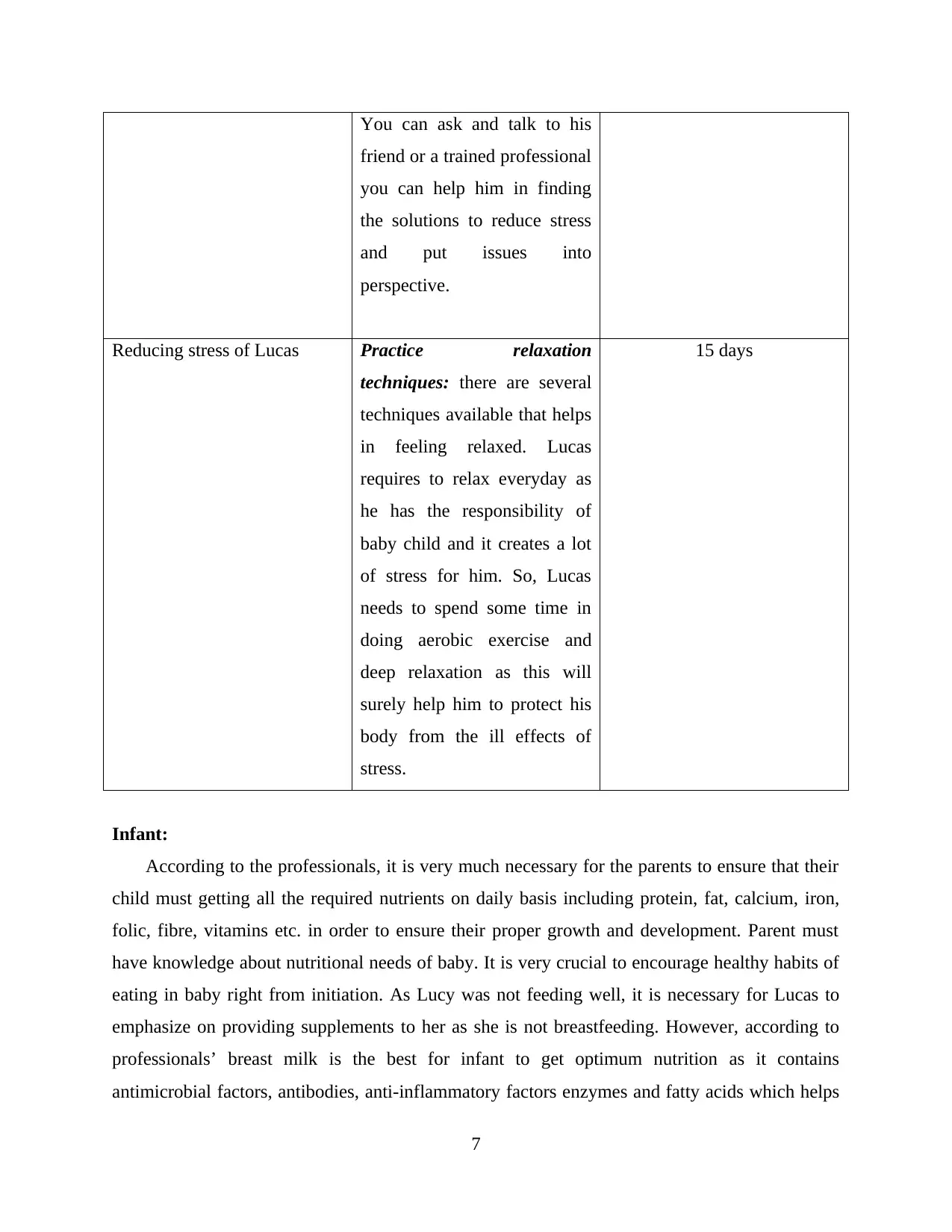
You can ask and talk to his
friend or a trained professional
you can help him in finding
the solutions to reduce stress
and put issues into
perspective.
Reducing stress of Lucas Practice relaxation
techniques: there are several
techniques available that helps
in feeling relaxed. Lucas
requires to relax everyday as
he has the responsibility of
baby child and it creates a lot
of stress for him. So, Lucas
needs to spend some time in
doing aerobic exercise and
deep relaxation as this will
surely help him to protect his
body from the ill effects of
stress.
15 days
Infant:
According to the professionals, it is very much necessary for the parents to ensure that their
child must getting all the required nutrients on daily basis including protein, fat, calcium, iron,
folic, fibre, vitamins etc. in order to ensure their proper growth and development. Parent must
have knowledge about nutritional needs of baby. It is very crucial to encourage healthy habits of
eating in baby right from initiation. As Lucy was not feeding well, it is necessary for Lucas to
emphasize on providing supplements to her as she is not breastfeeding. However, according to
professionals’ breast milk is the best for infant to get optimum nutrition as it contains
antimicrobial factors, antibodies, anti-inflammatory factors enzymes and fatty acids which helps
7
friend or a trained professional
you can help him in finding
the solutions to reduce stress
and put issues into
perspective.
Reducing stress of Lucas Practice relaxation
techniques: there are several
techniques available that helps
in feeling relaxed. Lucas
requires to relax everyday as
he has the responsibility of
baby child and it creates a lot
of stress for him. So, Lucas
needs to spend some time in
doing aerobic exercise and
deep relaxation as this will
surely help him to protect his
body from the ill effects of
stress.
15 days
Infant:
According to the professionals, it is very much necessary for the parents to ensure that their
child must getting all the required nutrients on daily basis including protein, fat, calcium, iron,
folic, fibre, vitamins etc. in order to ensure their proper growth and development. Parent must
have knowledge about nutritional needs of baby. It is very crucial to encourage healthy habits of
eating in baby right from initiation. As Lucy was not feeding well, it is necessary for Lucas to
emphasize on providing supplements to her as she is not breastfeeding. However, according to
professionals’ breast milk is the best for infant to get optimum nutrition as it contains
antimicrobial factors, antibodies, anti-inflammatory factors enzymes and fatty acids which helps
7
Paraphrase This Document
Need a fresh take? Get an instant paraphrase of this document with our AI Paraphraser
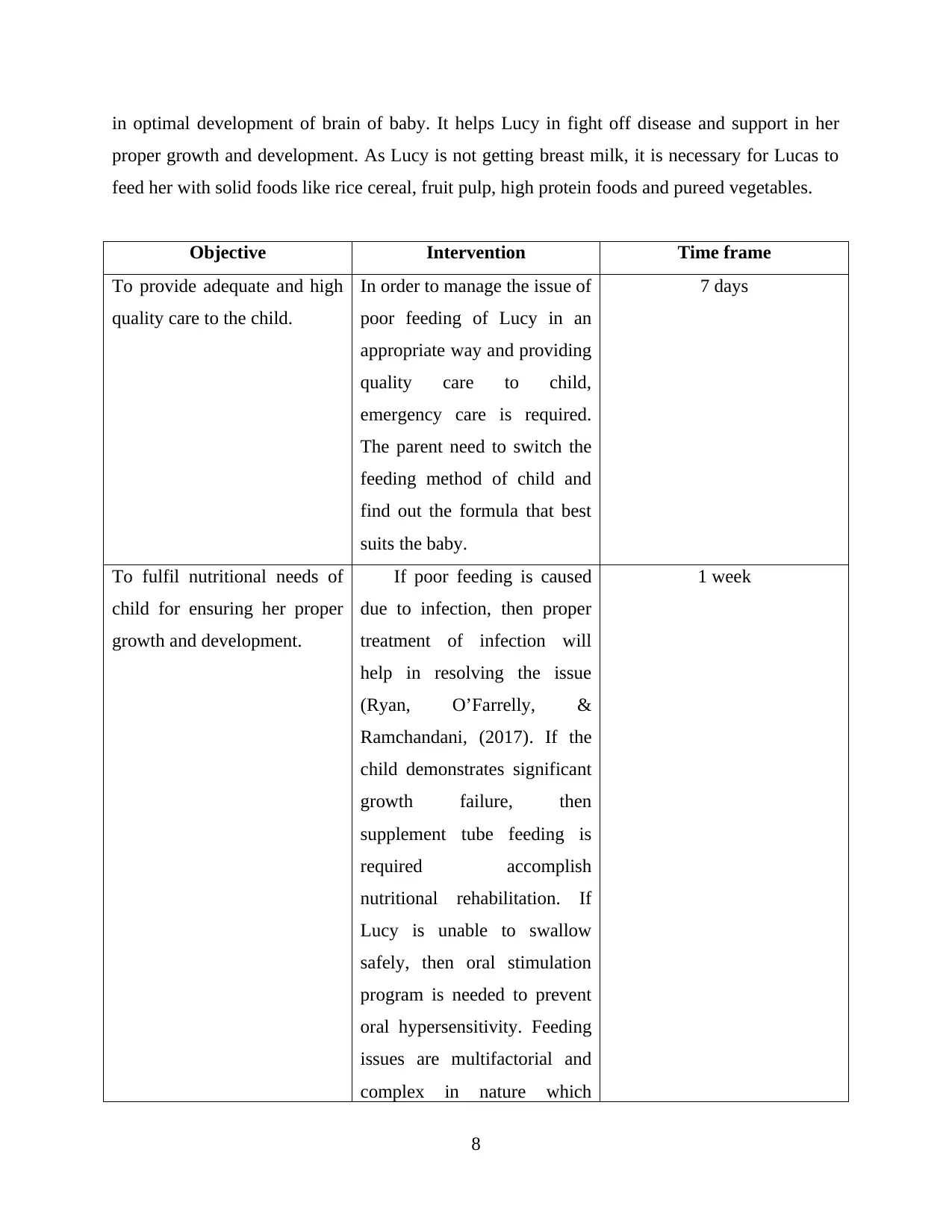
in optimal development of brain of baby. It helps Lucy in fight off disease and support in her
proper growth and development. As Lucy is not getting breast milk, it is necessary for Lucas to
feed her with solid foods like rice cereal, fruit pulp, high protein foods and pureed vegetables.
Objective Intervention Time frame
To provide adequate and high
quality care to the child.
In order to manage the issue of
poor feeding of Lucy in an
appropriate way and providing
quality care to child,
emergency care is required.
The parent need to switch the
feeding method of child and
find out the formula that best
suits the baby.
7 days
To fulfil nutritional needs of
child for ensuring her proper
growth and development.
If poor feeding is caused
due to infection, then proper
treatment of infection will
help in resolving the issue
(Ryan, O’Farrelly, &
Ramchandani, (2017). If the
child demonstrates significant
growth failure, then
supplement tube feeding is
required accomplish
nutritional rehabilitation. If
Lucy is unable to swallow
safely, then oral stimulation
program is needed to prevent
oral hypersensitivity. Feeding
issues are multifactorial and
complex in nature which
1 week
8
proper growth and development. As Lucy is not getting breast milk, it is necessary for Lucas to
feed her with solid foods like rice cereal, fruit pulp, high protein foods and pureed vegetables.
Objective Intervention Time frame
To provide adequate and high
quality care to the child.
In order to manage the issue of
poor feeding of Lucy in an
appropriate way and providing
quality care to child,
emergency care is required.
The parent need to switch the
feeding method of child and
find out the formula that best
suits the baby.
7 days
To fulfil nutritional needs of
child for ensuring her proper
growth and development.
If poor feeding is caused
due to infection, then proper
treatment of infection will
help in resolving the issue
(Ryan, O’Farrelly, &
Ramchandani, (2017). If the
child demonstrates significant
growth failure, then
supplement tube feeding is
required accomplish
nutritional rehabilitation. If
Lucy is unable to swallow
safely, then oral stimulation
program is needed to prevent
oral hypersensitivity. Feeding
issues are multifactorial and
complex in nature which
1 week
8
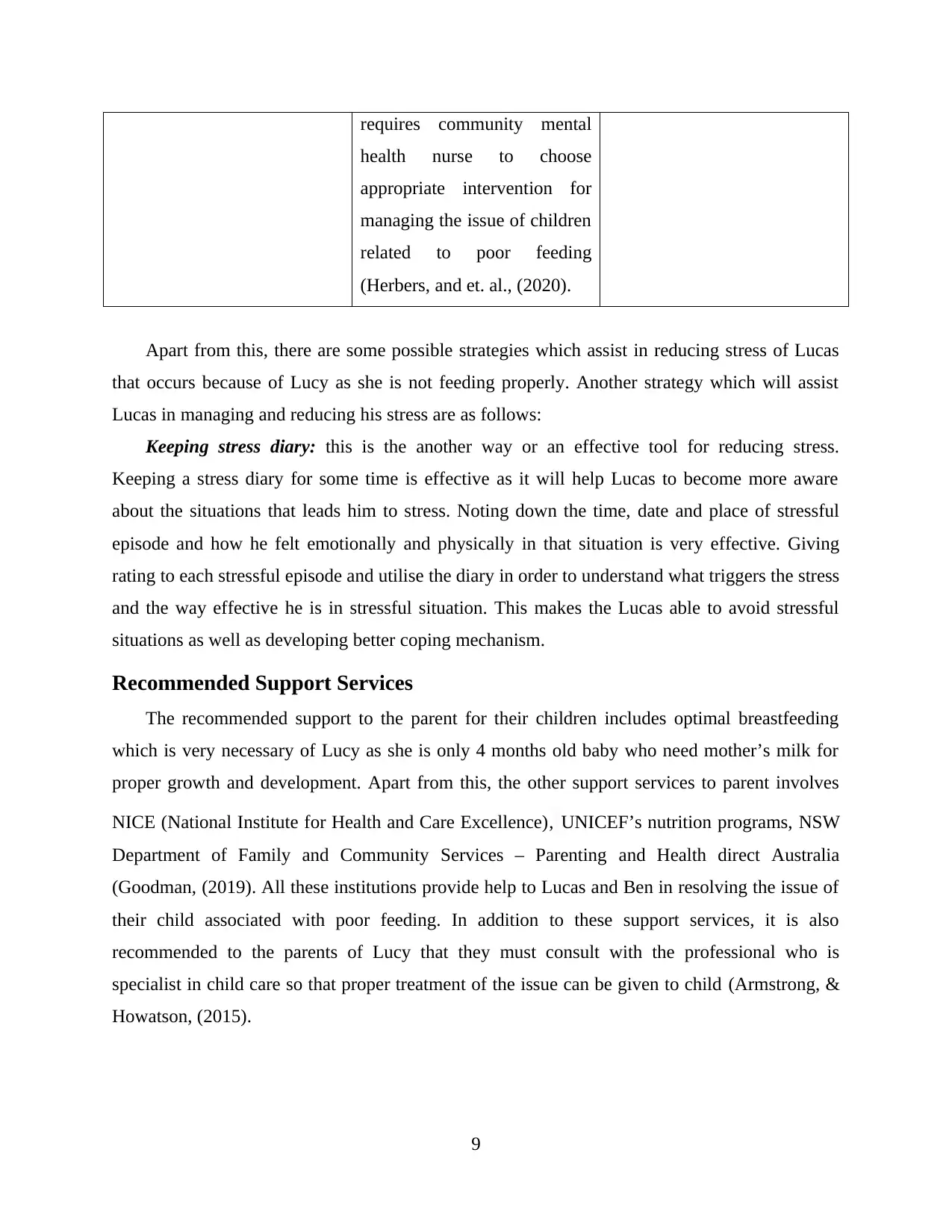
requires community mental
health nurse to choose
appropriate intervention for
managing the issue of children
related to poor feeding
(Herbers, and et. al., (2020).
Apart from this, there are some possible strategies which assist in reducing stress of Lucas
that occurs because of Lucy as she is not feeding properly. Another strategy which will assist
Lucas in managing and reducing his stress are as follows:
Keeping stress diary: this is the another way or an effective tool for reducing stress.
Keeping a stress diary for some time is effective as it will help Lucas to become more aware
about the situations that leads him to stress. Noting down the time, date and place of stressful
episode and how he felt emotionally and physically in that situation is very effective. Giving
rating to each stressful episode and utilise the diary in order to understand what triggers the stress
and the way effective he is in stressful situation. This makes the Lucas able to avoid stressful
situations as well as developing better coping mechanism.
Recommended Support Services
The recommended support to the parent for their children includes optimal breastfeeding
which is very necessary of Lucy as she is only 4 months old baby who need mother’s milk for
proper growth and development. Apart from this, the other support services to parent involves
NICE (National Institute for Health and Care Excellence), UNICEF’s nutrition programs, NSW
Department of Family and Community Services – Parenting and Health direct Australia
(Goodman, (2019). All these institutions provide help to Lucas and Ben in resolving the issue of
their child associated with poor feeding. In addition to these support services, it is also
recommended to the parents of Lucy that they must consult with the professional who is
specialist in child care so that proper treatment of the issue can be given to child (Armstrong, &
Howatson, (2015).
9
health nurse to choose
appropriate intervention for
managing the issue of children
related to poor feeding
(Herbers, and et. al., (2020).
Apart from this, there are some possible strategies which assist in reducing stress of Lucas
that occurs because of Lucy as she is not feeding properly. Another strategy which will assist
Lucas in managing and reducing his stress are as follows:
Keeping stress diary: this is the another way or an effective tool for reducing stress.
Keeping a stress diary for some time is effective as it will help Lucas to become more aware
about the situations that leads him to stress. Noting down the time, date and place of stressful
episode and how he felt emotionally and physically in that situation is very effective. Giving
rating to each stressful episode and utilise the diary in order to understand what triggers the stress
and the way effective he is in stressful situation. This makes the Lucas able to avoid stressful
situations as well as developing better coping mechanism.
Recommended Support Services
The recommended support to the parent for their children includes optimal breastfeeding
which is very necessary of Lucy as she is only 4 months old baby who need mother’s milk for
proper growth and development. Apart from this, the other support services to parent involves
NICE (National Institute for Health and Care Excellence), UNICEF’s nutrition programs, NSW
Department of Family and Community Services – Parenting and Health direct Australia
(Goodman, (2019). All these institutions provide help to Lucas and Ben in resolving the issue of
their child associated with poor feeding. In addition to these support services, it is also
recommended to the parents of Lucy that they must consult with the professional who is
specialist in child care so that proper treatment of the issue can be given to child (Armstrong, &
Howatson, (2015).
9
⊘ This is a preview!⊘
Do you want full access?
Subscribe today to unlock all pages.

Trusted by 1+ million students worldwide
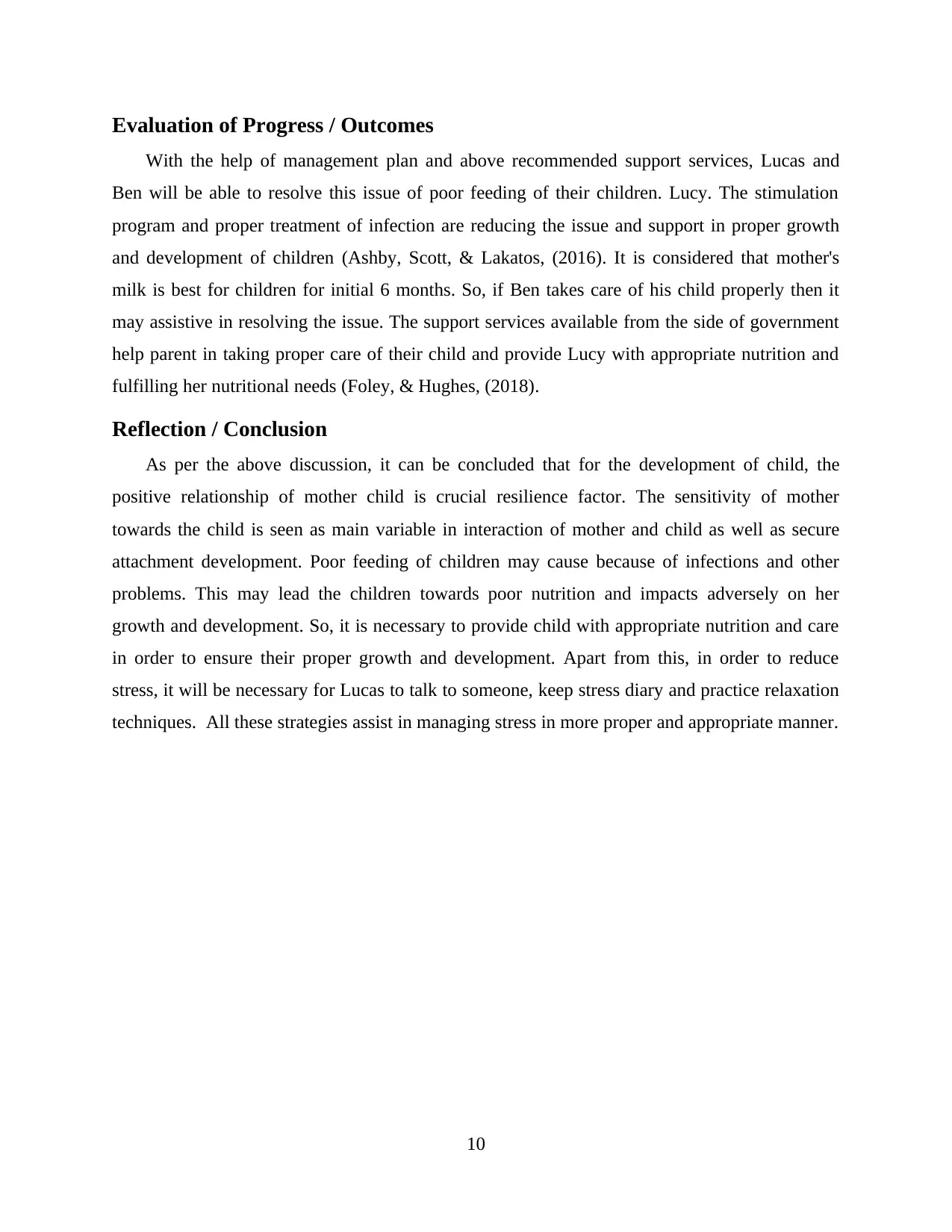
Evaluation of Progress / Outcomes
With the help of management plan and above recommended support services, Lucas and
Ben will be able to resolve this issue of poor feeding of their children. Lucy. The stimulation
program and proper treatment of infection are reducing the issue and support in proper growth
and development of children (Ashby, Scott, & Lakatos, (2016). It is considered that mother's
milk is best for children for initial 6 months. So, if Ben takes care of his child properly then it
may assistive in resolving the issue. The support services available from the side of government
help parent in taking proper care of their child and provide Lucy with appropriate nutrition and
fulfilling her nutritional needs (Foley, & Hughes, (2018).
Reflection / Conclusion
As per the above discussion, it can be concluded that for the development of child, the
positive relationship of mother child is crucial resilience factor. The sensitivity of mother
towards the child is seen as main variable in interaction of mother and child as well as secure
attachment development. Poor feeding of children may cause because of infections and other
problems. This may lead the children towards poor nutrition and impacts adversely on her
growth and development. So, it is necessary to provide child with appropriate nutrition and care
in order to ensure their proper growth and development. Apart from this, in order to reduce
stress, it will be necessary for Lucas to talk to someone, keep stress diary and practice relaxation
techniques. All these strategies assist in managing stress in more proper and appropriate manner.
10
With the help of management plan and above recommended support services, Lucas and
Ben will be able to resolve this issue of poor feeding of their children. Lucy. The stimulation
program and proper treatment of infection are reducing the issue and support in proper growth
and development of children (Ashby, Scott, & Lakatos, (2016). It is considered that mother's
milk is best for children for initial 6 months. So, if Ben takes care of his child properly then it
may assistive in resolving the issue. The support services available from the side of government
help parent in taking proper care of their child and provide Lucy with appropriate nutrition and
fulfilling her nutritional needs (Foley, & Hughes, (2018).
Reflection / Conclusion
As per the above discussion, it can be concluded that for the development of child, the
positive relationship of mother child is crucial resilience factor. The sensitivity of mother
towards the child is seen as main variable in interaction of mother and child as well as secure
attachment development. Poor feeding of children may cause because of infections and other
problems. This may lead the children towards poor nutrition and impacts adversely on her
growth and development. So, it is necessary to provide child with appropriate nutrition and care
in order to ensure their proper growth and development. Apart from this, in order to reduce
stress, it will be necessary for Lucas to talk to someone, keep stress diary and practice relaxation
techniques. All these strategies assist in managing stress in more proper and appropriate manner.
10
Paraphrase This Document
Need a fresh take? Get an instant paraphrase of this document with our AI Paraphraser
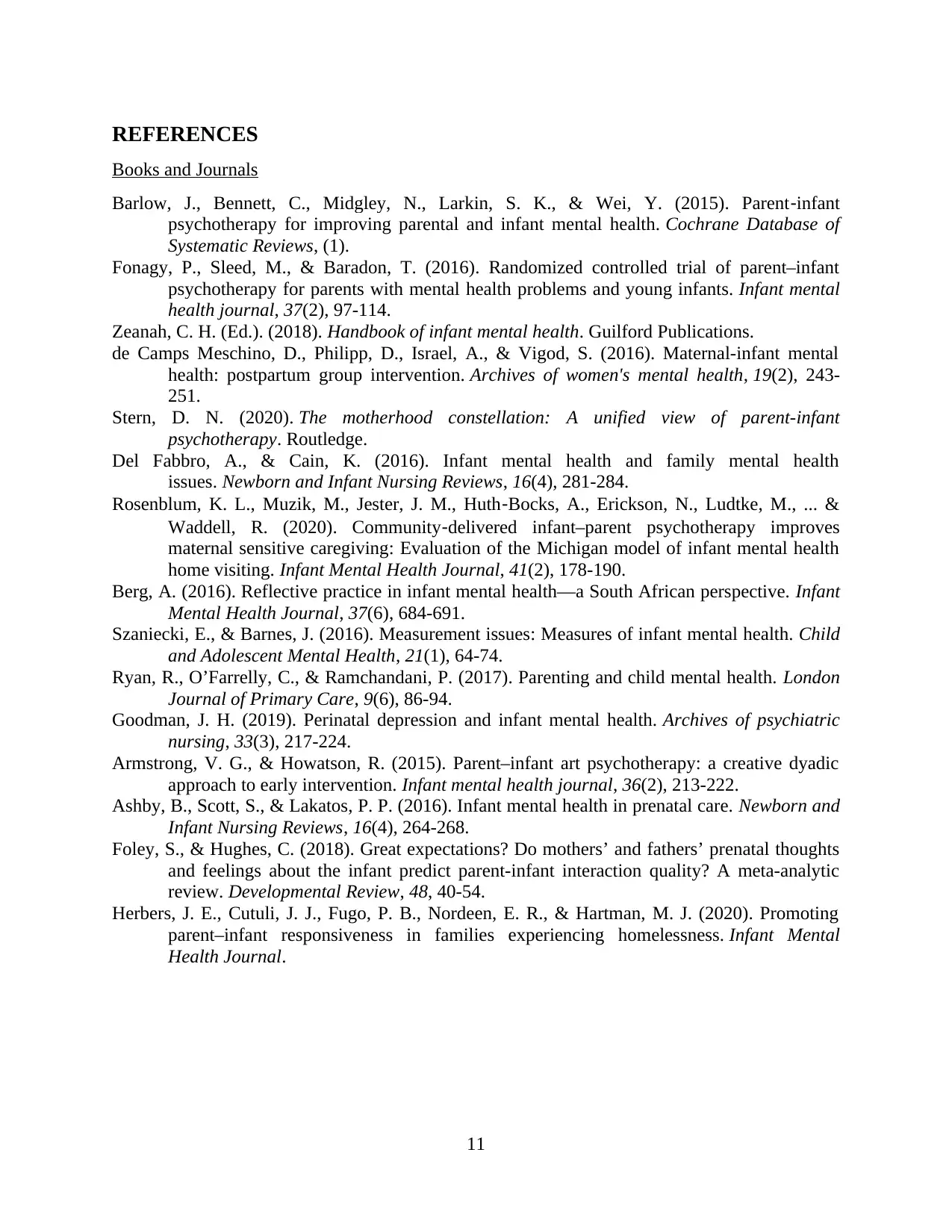
REFERENCES
Books and Journals
Barlow, J., Bennett, C., Midgley, N., Larkin, S. K., & Wei, Y. (2015). Parent‐infant
psychotherapy for improving parental and infant mental health. Cochrane Database of
Systematic Reviews, (1).
Fonagy, P., Sleed, M., & Baradon, T. (2016). Randomized controlled trial of parent–infant
psychotherapy for parents with mental health problems and young infants. Infant mental
health journal, 37(2), 97-114.
Zeanah, C. H. (Ed.). (2018). Handbook of infant mental health. Guilford Publications.
de Camps Meschino, D., Philipp, D., Israel, A., & Vigod, S. (2016). Maternal-infant mental
health: postpartum group intervention. Archives of women's mental health, 19(2), 243-
251.
Stern, D. N. (2020). The motherhood constellation: A unified view of parent-infant
psychotherapy. Routledge.
Del Fabbro, A., & Cain, K. (2016). Infant mental health and family mental health
issues. Newborn and Infant Nursing Reviews, 16(4), 281-284.
Rosenblum, K. L., Muzik, M., Jester, J. M., Huth‐Bocks, A., Erickson, N., Ludtke, M., ... &
Waddell, R. (2020). Community‐delivered infant–parent psychotherapy improves
maternal sensitive caregiving: Evaluation of the Michigan model of infant mental health
home visiting. Infant Mental Health Journal, 41(2), 178-190.
Berg, A. (2016). Reflective practice in infant mental health—a South African perspective. Infant
Mental Health Journal, 37(6), 684-691.
Szaniecki, E., & Barnes, J. (2016). Measurement issues: Measures of infant mental health. Child
and Adolescent Mental Health, 21(1), 64-74.
Ryan, R., O’Farrelly, C., & Ramchandani, P. (2017). Parenting and child mental health. London
Journal of Primary Care, 9(6), 86-94.
Goodman, J. H. (2019). Perinatal depression and infant mental health. Archives of psychiatric
nursing, 33(3), 217-224.
Armstrong, V. G., & Howatson, R. (2015). Parent–infant art psychotherapy: a creative dyadic
approach to early intervention. Infant mental health journal, 36(2), 213-222.
Ashby, B., Scott, S., & Lakatos, P. P. (2016). Infant mental health in prenatal care. Newborn and
Infant Nursing Reviews, 16(4), 264-268.
Foley, S., & Hughes, C. (2018). Great expectations? Do mothers’ and fathers’ prenatal thoughts
and feelings about the infant predict parent-infant interaction quality? A meta-analytic
review. Developmental Review, 48, 40-54.
Herbers, J. E., Cutuli, J. J., Fugo, P. B., Nordeen, E. R., & Hartman, M. J. (2020). Promoting
parent–infant responsiveness in families experiencing homelessness. Infant Mental
Health Journal.
11
Books and Journals
Barlow, J., Bennett, C., Midgley, N., Larkin, S. K., & Wei, Y. (2015). Parent‐infant
psychotherapy for improving parental and infant mental health. Cochrane Database of
Systematic Reviews, (1).
Fonagy, P., Sleed, M., & Baradon, T. (2016). Randomized controlled trial of parent–infant
psychotherapy for parents with mental health problems and young infants. Infant mental
health journal, 37(2), 97-114.
Zeanah, C. H. (Ed.). (2018). Handbook of infant mental health. Guilford Publications.
de Camps Meschino, D., Philipp, D., Israel, A., & Vigod, S. (2016). Maternal-infant mental
health: postpartum group intervention. Archives of women's mental health, 19(2), 243-
251.
Stern, D. N. (2020). The motherhood constellation: A unified view of parent-infant
psychotherapy. Routledge.
Del Fabbro, A., & Cain, K. (2016). Infant mental health and family mental health
issues. Newborn and Infant Nursing Reviews, 16(4), 281-284.
Rosenblum, K. L., Muzik, M., Jester, J. M., Huth‐Bocks, A., Erickson, N., Ludtke, M., ... &
Waddell, R. (2020). Community‐delivered infant–parent psychotherapy improves
maternal sensitive caregiving: Evaluation of the Michigan model of infant mental health
home visiting. Infant Mental Health Journal, 41(2), 178-190.
Berg, A. (2016). Reflective practice in infant mental health—a South African perspective. Infant
Mental Health Journal, 37(6), 684-691.
Szaniecki, E., & Barnes, J. (2016). Measurement issues: Measures of infant mental health. Child
and Adolescent Mental Health, 21(1), 64-74.
Ryan, R., O’Farrelly, C., & Ramchandani, P. (2017). Parenting and child mental health. London
Journal of Primary Care, 9(6), 86-94.
Goodman, J. H. (2019). Perinatal depression and infant mental health. Archives of psychiatric
nursing, 33(3), 217-224.
Armstrong, V. G., & Howatson, R. (2015). Parent–infant art psychotherapy: a creative dyadic
approach to early intervention. Infant mental health journal, 36(2), 213-222.
Ashby, B., Scott, S., & Lakatos, P. P. (2016). Infant mental health in prenatal care. Newborn and
Infant Nursing Reviews, 16(4), 264-268.
Foley, S., & Hughes, C. (2018). Great expectations? Do mothers’ and fathers’ prenatal thoughts
and feelings about the infant predict parent-infant interaction quality? A meta-analytic
review. Developmental Review, 48, 40-54.
Herbers, J. E., Cutuli, J. J., Fugo, P. B., Nordeen, E. R., & Hartman, M. J. (2020). Promoting
parent–infant responsiveness in families experiencing homelessness. Infant Mental
Health Journal.
11
1 out of 11
Related Documents
Your All-in-One AI-Powered Toolkit for Academic Success.
+13062052269
info@desklib.com
Available 24*7 on WhatsApp / Email
![[object Object]](/_next/static/media/star-bottom.7253800d.svg)
Unlock your academic potential
Copyright © 2020–2025 A2Z Services. All Rights Reserved. Developed and managed by ZUCOL.





